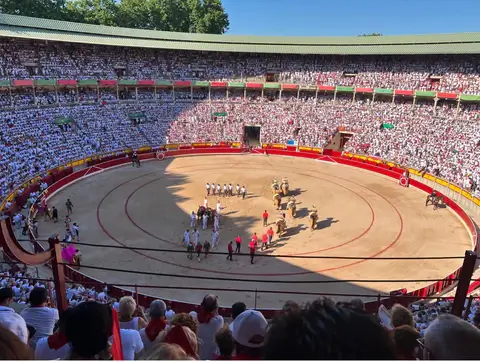
Table of Contents
As I headed to the bullfight, I can tell you that I knew very little about this tradition before I attended. Before attending, I can’t say I thought much about why it existed or what its purpose was. I knew there was a matador and a long history of bullfighting in Spain, but anything other than waving a little red flag to make the bull charge, I had no idea about. Seeing the matador and the first bull dance to its death was just about enough for me, but then I found out that there were five more rounds (bulls) after that. Each round takes around 20 minutes, from the release of the bull to the placement of the pica (swords in the neck) to the final kill. The matador’s performance was indeed the best part of the show. He parades himself around the bull and demonstrates his level of cockiness with the flick of his head up and down. All I could think of at that point was that he was saying, “Hey Ese,” with his nod. Lol.
So what is bullfighting and why do they do it? When analyzing bullfights, there of course is the good, bad, and ugly. Bullfighting is engrained in Spanish culture. Bullfights generally consist of 3 bullfighters, 6 bulls, and a 2-2.5 hours dance between the fighters and the bulls ending in death.
According to Earth and Animals:
“While its exact origins are unknown, the history of bullfighting is believed to have emerged in connection with ancient fertility rites. In 1567, Pope Pius V decreed that “exhibitions of tortured beasts or bulls is contrary to Christian duty and piety.” He called for “an end to such bloody amusements, abject and more appropriate for devils than for men.” The penalty for violating this decree, which has never been repealed, is excommunication. In 1725, bullfighting began to assume its present state when Francisco Romero invented a stick with a red cloth suspended from the end, which he used to tease and torment the bulls. Today the history of bullfighting maneuvers became defined in the 1700s and has changed little since. Recent polls of Spanish citizens show they are not particularly interested in attending bullfights, but tourists’ money keeps bullfight profiteers in business”
The earliest recorded bullfights as we know them today can be dated to the Middle Ages. These were held in plazas, town squares, and evolved from a combination of the earlier Iberian and Roman practices. During this period, the bullfight was typically a contest between individuals on horseback and the bull, and it was more of a display of chivalry and equestrian skills than the spectacle we associate with modern bullfighting.
The 18th century saw a significant transformation in bullfighting with the emergence of the matador as a central figure. Francisco Romero is often credited with introducing the use of the muleta, a small red cape, and refining the style and rules of the bullfight. This shift marked the transition from the earlier mounted bullfighting to the more recognizable form we know today, with matadors facing the bulls on foot.
It’s worth noting that bullfighting has not been without controversy throughout its history. In 1567, Pope Pius V issued a decree condemning the cruel treatment of animals in bullfights and called for their end. This papal decree was significant, as it raised ethical and religious questions about the practice. However, bullfighting continued despite papal opposition and even excommunication for its participants.
Despite these early controversies, bullfighting became entrenched in Spanish culture and spread to other Spanish-speaking countries. The 19th and 20th centuries brought further refinements to the art and rules of bullfighting. It became a symbol of Spanish identity and a popular form of entertainment.
In recent times, however, attitudes have begun to change. Animal welfare concerns have led to protests and even bans on bullfighting in some regions of Spain. Public opinion on the practice is divided, with some viewing it as an important cultural tradition and others as a cruel and outdated spectacle.
There are 3 matadors and each one has 2 bulls to take on, for a total of 6 bulls. He’s one of the last to touch the bull, but there are a few steps that take place before the main part of the performance.
The matador’s challenge and begin to tire out the not-so-happy bull. The matador uses a yellow and fuchsia cape rather than the red to provoke the bull to charge at them. Waving this cape starts the process of tiring out the bull, as the others push the bull toward the Picador “the guy on the horse.
When the bull gets close enough to the picadors, he stabs it with a stick that has a razor-like blade (pica) attached to it into the shoulder muscle as the bull rams his horse with his horns and begins to bleed. The poor horse is blindfolded but thankfully armored with a “peto,” a thick mattress-like coat of armor so he won’t get stabbed by the horns. Although, I’m sure he feels the solid thud of the bull ramming his side. Personally, I’d be ticked if I was the horse. Blindfold me and then have a 2,000 bull come at me with pointy horns. Aww hell naw. The blade is rammed into the bull’s shoulder so that the bull begins to drop his head down, so it allows for easier access later in the fight.
Several other mandators then come out with colorful barbed sticks to stick in the back of the bull 2 at a time. They wear him out further as the bull begins to bleed, and the pain of the sticks causes the bull to further drop his head. After 6 sticks are placed it is tied for the final act of the show.
The senior mandator comes out and begins his portion of the show. Taunting and dancing with him, flag and sword until it’s time to find the opening on his back to thrust into. Oddly enough the bull seems to be a part of his own performance. As if on cue he waits until he’s told to come past as the matador lines it up to shove it in with one try. This portion should not take more than 10 minutes from start to finish and is where the matador demonstrates his level of skill and artistry. He uses the red cape which is smaller, as well as a muleta. The muleta is a stick that looks similar to a sword which will also prove the bull to charge at it, getting the bull closer to the matador’s body. The closer the bull passes, the higher the skill, artistry, and courage a mandator shows. After a number of passes and the matador determines that the bull is tired and ready for the final step, he steps to the side and acquires the actual sword. As the mandator arranges himself in front of the bull, provoking the bull to run directly at the blade, the bull lowers his head, charges, and leaves the opening on the neck to smoothly allow the blade a place to enter in order to sever its aorta, which should kill the bull instantly.
If the matador misses the heart, the bull falls to the ground and another mandator comes to the stage with a dagger to finish him off. This can take one to numerous stabs to finish the bull. The history of bullfighting is judged by the Presidente and the crowd to determine if the mandator is worthy of the first ear, and other ear and tail.
A team of horses drags the carcass of the bull out of the arena and the crowd celebrates, which certainly illicit a number of emotions that you may not have initially been prepared for when you book your tickets.
Personally, I’d like to see a bit more of a fair and equitable fight if this ritual is to continue. The bulls seem to be very well-trained to move around the arena and don’t even take off running at the mandator unless the little flag is waived. If I were a bull and having a bunch of pointy sticks shoved into my neck, and the first opportunity when the matador turns his back on me, he’s gonna have a shiny new horn shoved up his… bleep. Now, make this challenge happen between multiple bulls, and fewer matadors, let the games begin! I’ll watch that!
“The first rule about fight club… we don’t talk about fight club.”
Now, if I would have done a bit of research beforehand, I would have known what makes for a good bullfight or at minimum, the purpose of a bullfight. I chose to attend because it’s something that’s been around for ages, but now, I can honestly say, I have no desire to do it again. It is a very cruel process that I don’t believe should exist; but without seeing it, knowing the history of bullfighting, and experiencing the violence, I wouldn’t have been able to tell all of you. It’s important to know the history of bullfighting, so there is at minimum an understanding of why it exists in order to develop changes in the future. I imagine in our society today, this is a ritual that will not stand the test of time.
While I can’t recommend attending a bullfight, I can recommend attending the Running of the Bulls. At least here, the bulls have a chance and the people, well, the people may not be so lucky. 😉
No matter where you go in life, whether it’s a bullfight or a soccer game, always remember to Travel Till You Drop!


Hi, Jill Here
Hi! I’m Jill, a Dallas, Texas girl traveling the world. After a career in the Air Force and touring over 50 countries later, my need to explore keeps going! It’s time to rock & roll and find all those places I never knew I was missing.
Table of Contents
Join me to get exclusive travel tips, giveaways and more!
Gallery
Copyright © 2023 | All Right Reserved